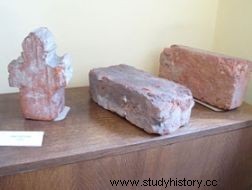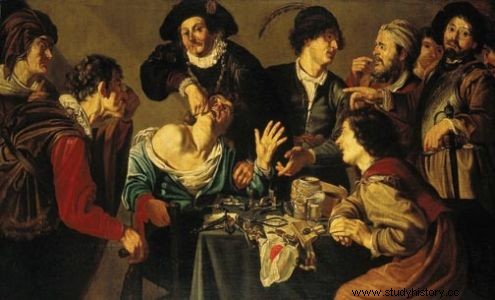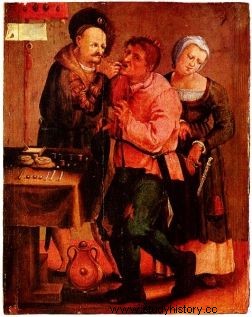Today, there are dozens of types of toothpaste, brushes and other articles on the market that confirm that "in order to have healthy teeth, you only need to want". In the modern era it was not so easy, and the proud Sarmatians used really original methods to keep a beautiful smile.
Sources leave no doubt that oral hygiene was of great importance in the Republic of Poland. Jakub Kazimierz Haur wrote at the end of the 17th century:
P a beautiful thing (...) to have white teeth and even which [a lady] had an English face in her beauty, when she has black teeth all that is marred by beauty , hence the fact that it smells from the mouth, and thus delights in offending .

To have clean teeth ... you only need to eat a brick? (photo of gothic bricks from the collection of the Museum in Chełmno. Aut. Ciacho5, license CC ASA 3.0).
According to the authorities of the time, what were the causes of tooth contamination? In the 17th century, Jerzy Baglini believed that the cause of a contaminated mouth was unhealthy air, the abuse of spicy and sour foods, and too frequent enjoyment of Bacchus and Venus
Sex is bad for your teeth. The iron stylus helps
Haur advised a simple and valid solution today:brush your teeth with clean water in the morning, after eating and at night. Maciej from Miechów recommended rinsing the mouth with rosemary water. Alexios of Piedmont suggested brushing his teeth with pearls.
His method gained recognition even in royal circles. It was used, for example, by the king of Denmark and Norway, Christian III. Wojciech Oczko advised, in order to strengthen the teeth, to use, among others, goat, sheep or cow milk, but also to rinse the mouth with violet, rose, lemon or orange water.

It is said that such an exclusive toothbrush with horsehair was used by Napoleon Bonaparte (Science Museum in London, license CC ASA 2.0).
In the 18th century, it was suggested to take care of the oral cavity with an iron stylus to clean the teeth . Experts also recommended the use of white salt mixed with broken brick and soot . At the same age, the first mentions of a toothbrush appear. Samuel Beimller mentions them in "Home Medic".
In the sixteenth century, the botanist and physician Szymon Syreński, in his armorial, which was published in Krakow in 1613, widely presented the dental problems of that time. Although his work did not contain any groundbreaking theories and in fact repeated the traditional state of affairs, it enjoyed great popularity and was read even at the end of the 18th century. Another proof that the issue of teeth was close to Poles.
A bit of human urine. And the teeth will be white again!
Sometimes, despite the use of all treatments, the teeth lost their shine. What was done to make them snow-white again?
One method was to wipe the teeth with egg shells or nut shells. In the 16th century, it was recommended to use roasted deer horn, salt and saltpetre. In the 17th century, it was advised to use grated stones or the so-called pebbles from the river.

If nothing else helped, it was left to extract the tooth… Without anesthesia.
Anyone who thinks that the Poles had the most ingenious ways to restore the shine to their teeth will be mistaken. In Spain, the use of specially stored urine was recommended. So if you think your smile is not as white as it should be, feel free to try one of the methods provided.
For toothache… Nicolaus Copernicus
Sometimes, despite the use of all hygienic procedures, the brave Sarmatian suffered a toothache. But take it easy, and old Polish experts could do it. Szymon from Łowicz recommended cooked wormwood, violets in wine or beer.

"Burn your gums and spit it out!" That's what Nicolaus Copernicus says.
The most famous Polish scientist also had his own ways of dealing with pain problems. Nicolaus Copernicus, who, apart from being an astronomer, also practiced medicine, created the following prescription against relieving ailments:
Rp. ringworm, peppercorns 1/3 unc., celery seed, pomegranate flower, mastic tree acorn bags, burnt bull horn, burnt red coral, half dr., rose flowers, 1 dr., sugar alum, half dr., of which a delicate powder will be formed so that the alcohol, which is then added with pure honey, becomes similar to liniment, but before that you need to clean the honey well from its impurities, then heat the gums and spit it out .
Worms in teeth
What, according to people, caused dental diseases in the Old Polish period? Until the nineteenth century, it was commonly believed that everything was to blame for ... worms that nest in the mouth. Franciszek Mymer wrote about this problem in such a rhyme in 1532, in his work "Good health, governance":
You have a rhyme and a headache,
Leaving eyes and bruised
Full belly, wormy tooth,
You are not to haunt baths.
The authors of medical herbariums recommended various ways to get rid of worms. Szymon z Łowicza recommended the following method:
When someone has Robacy's teeth, then take the hemp seed, brew them in a new pot until it starts to peel and put the stones in them nine hot ones. Then you will lean over the couple. Then the worms will come out, it is obvious .
In the 16th century, there were also other ideas to explain the causes of toothache. Wojciech Oczko believed that it was caused by scurvy gums leading to mouths-up .

"A peasant at the dentist's" in a 17th-century painting.
And for this, dozens of healing methods have undoubtedly been created. Some were more effective, others less effective. However, it is worth remembering that our ancestors were ready to do a lot to have a beautiful smile.
